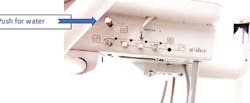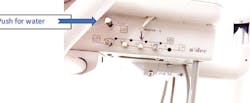Water safety
Protocol for flushing water lines
Noel Brandon Kelsch, RDH, RDHAP, MS
There is a lot of information in the news on water lines in the dental setting because of outbreaks of diseases associated with contaminated water from the dental unit. Over the next three issues of RDH, we will be looking at preventive measures for reduction of bacteria in dental water lines and assurance of compliance. This month, we will learn about standards and flushing lines. Next month, we will learn about testing lines, and finally, we will learn about shocking the lines.
It is very clear that water lines in the dental setting need to be maintained and tested for bacterial levels. All water in the dental unit must contain fewer than 500 colony-forming units per milliliter (CFU/mL); some unit instructions for use (IFU) state as low as 200 CFU/mL. You should always go with the lowest number. It is important to read your unit’s individual IFU and follow any directions that accompany it. The units that we use in the dental setting are governed by the FDA. Following the IFU that accompanies your unit is not a question for debate. It is a federal law.
Flushing lines
The water itself is governed by the EPA, which states that the water must meet the nationally recognized standards set by the EPA for drinking water (fewer than 500 CFU/mL for heterotrophic plate count) for routine dental treatment output water. If the IFU states 200 CFU/mL, you should go with the lower number as your standard. Surgical procedures require sterile water.
This unit has a master button for flushing all the lines at once. Hold the cords over a container and put this button, it will flush all the devices at once except the air water syringe. Photo by: Natalie Vanoli
Precautions before and between patients
Take precautions to prevent waterborne contamination of dental unit water lines. The CDC states the following:
At the start of the clinic day, all dental instruments that use water should be run to discharge water for several minutes. This practice will help flush out any patient materials that may have entered the water lines and disrupt the formation of biofilm.1 Be sure to expel the water out of the handpiece lines after you flush the line, if appropriate for your handpiece.
After each patient, discharge water and air for a minimum of 20–30 seconds from any dental device connected to the dental water system that enters the patient’s mouth (e.g., handpieces, ultrasonic scalers, and air/water syringe).
At the end of the day, flush all lines one final time for several minutes. I recommend that you expel water in all lines so that you can expose the water lines to air to disrupt biofilm formation and kill bacteria.
These simple safety procedures are designed to prevent the dangerous buildup of biofilm and bacterial colonies in the equipment water lines, thus reducing contamination.
NOEL BRANDON KELSCH, RDH, RDHAP, MS, is a syndicated columnist, writer, speaker, and cartoonist. She serves on the editorial review committee for the Organization for Safety, Asepsis and Prevention newsletter and has received many national awards. Kelsch owns her dental hygiene practice that focuses on access to care for all and helps facilitate the Simi Valley Free Dental Clinic. She has devoted much of her 35 years in dentistry to educating people about the devastating effects of methamphetamines and drug use. She is a past president of the California Dental Hygienists’ Association.
References
1. Medical and dental equipment connected to main water systems. Centers for Disease Control and Prevention website. https://www.cdc.gov/healthywater/other/medical/med_dental.html. Updated October 11, 2016. Accessed January 29, 2018.
2. Sehulster L, Chinn RY; CDC; HICPAC. Guidelines for environmental infection control in health-care facilities. Recommendations of CDC and the Healthcare Infection Control Practices Advisory Committee (HICPAC). MMWR Recomm Rep. 2003;52(RR-10):21. http://www.cdc.gov/mmwr/PDF/rr/rr5210.pdf.
3. Sehulster LM, Chinn RYW, Arduino MJ, et al. Guidelines for environmental infection control in health-care facilities. Recommendations from CDC and the Healthcare Infection Control Practices Advisory Committee (HICPAC). https://www.cdc.gov/infectioncontrol/pdf/guidelines/environmental-guidelines.pdf. Published 2004. Accessed January 29, 2018.


